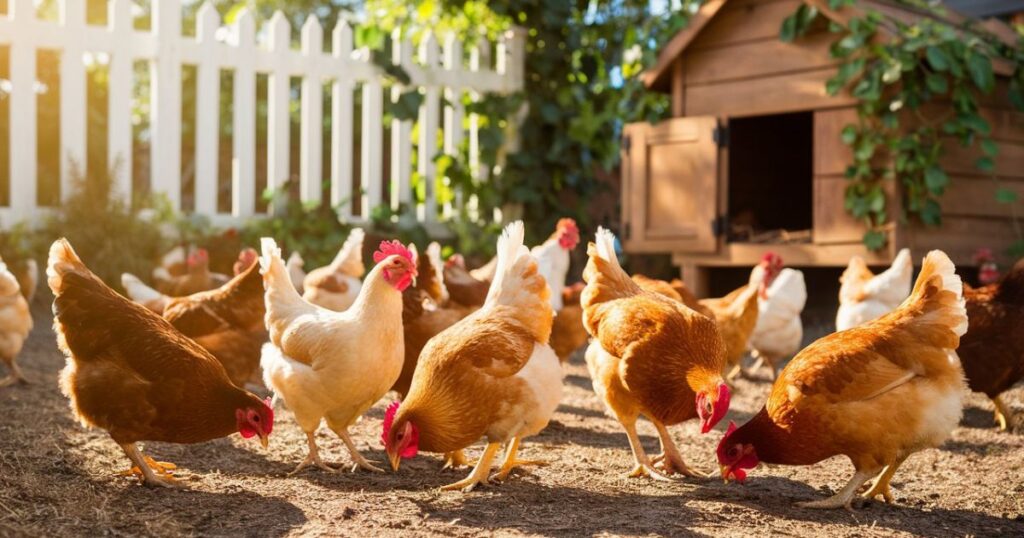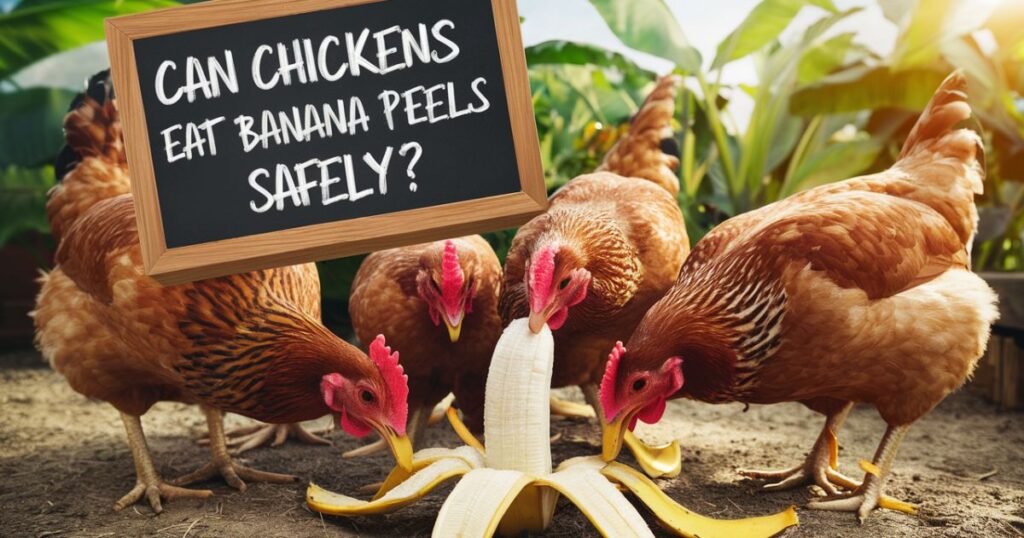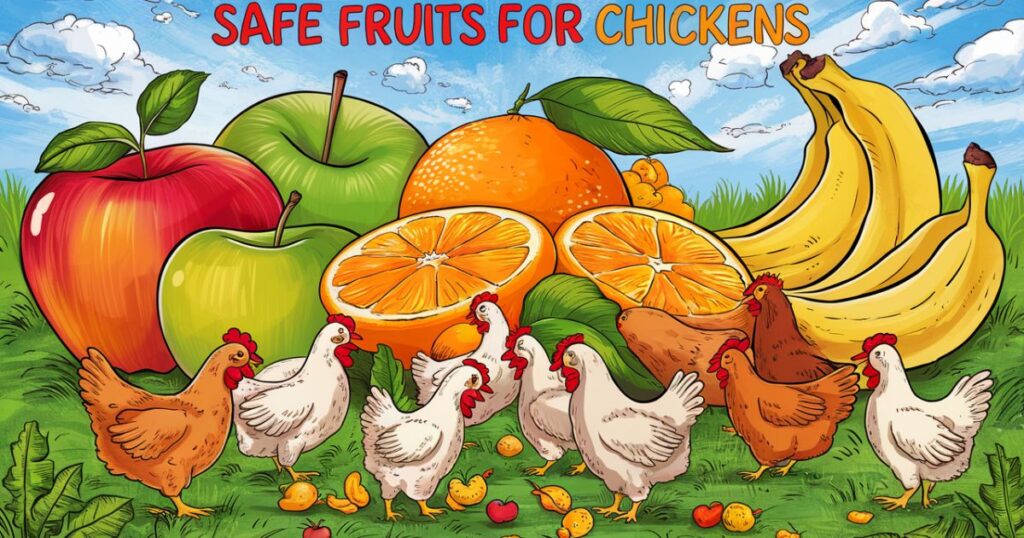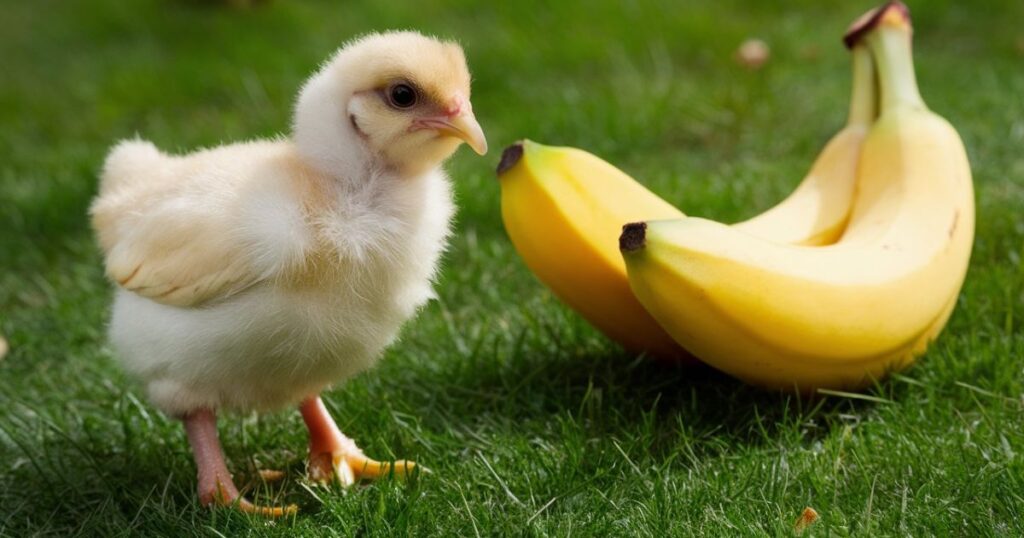Raising backyard chickens has become an increasingly popular trend, transcending the rural idyll and finding its way into suburban and urban homes worldwide. This shift not only provides fresh, locally-sourced eggs but also offers a unique opportunity to reduce household waste and embrace a more sustainable lifestyle.
One commonly asked question among chicken enthusiasts is: Can chickens eat banana peels? The answer is a resounding yes! Incorporating banana peels into your chicken’s diet can provide numerous benefits while aligning with the principles of sustainable living and zero waste.
In this comprehensive guide, we’ll explore the journey of sustainable living through backyard chickens, the advantages of including banana peels in their diet, and practical tips for safely and effectively incorporating this nutritious treat into their feeding routine.
The Journey to Sustainable Living: Backyard Chickens

Sustainable living is a lifestyle that aims to reduce one’s environmental impact by making conscious choices that respect the connection between humanity and nature, ensuring a healthy planet for future generations. One small but impactful change that embodies this philosophy is the practice of rearing backyard chickens.
Keeping chickens in your backyard not only provides a source of fresh, organic eggs but also significantly reduces the carbon footprint associated with conventional egg production. By eliminating the need for transportation and excessive packaging, you’re actively contributing to a more eco-friendly lifestyle.
Chickens act as natural pest controllers, reducing the need for harmful pesticides and promoting a healthier ecosystem in your garden. Beyond the environmental benefits, raising backyard chickens offers a unique educational opportunity for both adults and children.
It fosters a deeper understanding of where our food comes from, the importance of animal welfare, and the cyclical nature of sustainable living. As you witness your chickens transforming kitchen scraps into nutrient-rich chicken manure for your garden, you’ll gain a newfound appreciation for the interconnectedness of all living beings.
Keeping backyard chickens is not just about fresh eggs; it’s about reconnecting with the natural world and embracing a more mindful way of living.” – Jane Doe, Sustainable Living Advocate.
Read More : Which Birds Lay Blue Eggs?
Why Consider Banana Peels in a Chicken’s Diet?
Often overlooked and discarded as waste, banana peels are a treasure trove of nutrients that can significantly benefit your backyard flock. By incorporating this kitchen byproduct into your chicken’s diet, you’re not only reducing food waste but also providing them with valuable nourishment.
Banana peels are rich in potassium, a vital mineral that supports heart function and muscle growth in chickens. They also contain dietary fiber, which aids in digestion and promotes a healthy gut microbiome.
Banana peels are packed with various vitamins, including vitamin C, vitamin B6, and folate, all of which contribute to overall health and well-being. Feeding your chickens banana peels is a prime example of conscious consumerism and mindful living.
Can Chickens Eat Banana Peels Safely?

The short answer is yes, banana peels are safe for chickens to consume, provided they are free from harmful pesticides, contaminants, or mold. However, it’s essential to consider the tough texture of banana peels, which can make them challenging for chickens to peck at and digest in their whole form.
To make banana peels more appealing and easily digestible for your flock, consider chopping or drying and crushing them into smaller pieces. This preparation not only makes the peels more manageable for your chickens but also enhances their overall palatability.
It’s crucial to remember that while banana peels offer nutritional value, they should not replace a balanced chicken feed diet. Instead, treat them as a supplementary treat, providing variety and additional nutrients to complement their regular chicken feed ingredients.
Exploring the Benefits of Banana Peels for Chickens
Incorporating banana peels into your chickens’ diet offers a multitude of benefits that extend beyond reducing food waste. Let’s delve deeper into the specific advantages these nutrient-rich treats can provide for your feathered friends.
1. Potassium for Heart and Muscle Health Banana peels are an excellent source of potassium, a mineral that plays a crucial role in maintaining healthy heart function and promoting strong muscle growth in chickens. By incorporating this potassium-rich treat into their diet, you’re supporting their overall cardiovascular and muscular health.
2. Dietary Fiber for Digestive Well-being The high fiber content found in banana peels can greatly benefit your chickens’ digestive system. Fiber aids in the smooth passage of food through the digestive tract, preventing constipation and promoting regular bowel movements. A well-functioning digestive system is essential for optimal nutrient absorption and overall chicken wellness.
3. Vitamins for Overall Health In addition to potassium and fiber, banana peels are rich in various vitamins, including vitamin C, vitamin B6, and folate. These essential nutrients contribute to a strong immune system, healthy skin and feathers, and proper metabolic function in chickens.
4. Better Egg Quality Healthier chickens tend to produce higher-quality eggs with richer nutritional profiles. By incorporating banana peels into their diet and supporting their overall well-being, you’re indirectly contributing to the quality and taste of the backyard eggs you harvest.
Remember, while banana peels offer numerous benefits, it’s crucial to maintain a balanced and diverse diet for your flock. Moderation is key, and banana peels should be treated as a supplementary treat rather than a staple food source.
Other Safe Fruits for Chickens

Banana peels are not the only fruit scraps that can be safely incorporated into your chickens’ diet. Many other fruits and their byproducts are excellent sources of essential nutrients and can provide variety in your flock’s feeding routine. Here are some safe fruit options to consider:
- Apples (without seeds)
- Berries (strawberries, blueberries, raspberries)
- Melons (watermelon, cantaloupe)
- Grapes
- Peaches (without pits)
- Pears
Each of these fruits offers its own unique nutritional profile, providing a range of vitamins, minerals, and antioxidants that can benefit your chickens’ health.
It’s important to note that not all fruit waste is suitable for chicken consumption. Avoid feeding your flock anything that contains high levels of harmful substances, such as caffeine (found in coffee grounds) or theobromine (present in chocolate).
Ensure that any fruit seeds or pits are removed before feeding, as they can be potential choking hazards or contain toxins.
DIY Hacks: Preparing Banana Peels for Your Chickens
Introducing banana peels into your chickens’ diet can be a fun and rewarding DIY project. Not only does it reduce waste, but it also allows you to provide a nutrient-rich treat for your feathered friends. Here’s a step-by-step guide to preparing banana peels for your chickens:
- Collect and Clean: Gather banana peels from your household and rinse them thoroughly to remove any dirt or debris.
- Dry the Peels: Spread the clean banana peels out on a baking tray and place them in the sun or in a low-temperature oven (around 200°F or 93°C) until they are completely dried and brittle. This process can take several hours, depending on the humidity levels and oven temperature.
- Grind into Powder: Once the banana peels are fully dried, transfer them to a blender or food processor and grind them into a fine powder.
- Storage: Transfer the banana peel powder into an airtight container and store it in a cool, dry place. This powder can be kept for several months, ensuring a consistent supply of this nutritious supplement for your flock.
- Feeding: When it’s time to feed your chickens, simply sprinkle a tablespoon or two of the banana peel powder over their regular feed or mix it into their favorite treats. The powder can also be used as a top dressing for their feed, adding an extra boost of nutrients.
By taking the time to prepare banana peels in this manner, you’re not only reducing waste but also creating a nutrient-dense supplement that can contribute to the overall health and well-being of your backyard flock.
The Banana Peel Cycle: Composting with Chickens
In a truly sustainable household, waste is viewed as a valuable resource rather than something to be discarded. The banana peels that your chickens don’t consume can be easily integrated into your composting system, creating a full circular cycle that embodies the principles of zero waste living.
Chickens themselves play a crucial role in the composting process. Their manure is highly nitrogen-rich, a vital element in breaking down organic matter and transforming it into nutrient-dense compost.
By combining their manure with the banana peels and other organic waste from your kitchen and garden, you’re creating the perfect environment for a thriving compost pile.
This composting process not only reduces the amount of waste sent to landfills but also produces a rich, organic fertilizer that can be used to nourish your garden or lawn. The nitrogen-rich chicken manure acts as a natural accelerant, speeding up the decomposition process and ensuring a steady supply of nutrient-dense compost.
By incorporating banana peels into this cycle, you’re taking a holistic approach to sustainable living, where every byproduct serves a purpose and contributes to a healthier, more eco-friendly lifestyle.
Chickens and Conscious Consumerism
Keeping backyard chickens and feeding them kitchen scraps like banana peels is a powerful example of conscious consumerism – a mindset that challenges us to think critically about our consumption habits and their impact on the environment.
As conscious consumers, we strive to make informed decisions that prioritize sustainability, ethical sourcing, and waste reduction. By choosing to raise chickens and incorporate their waste into our gardening practices.
We’re actively reducing our reliance on industrialised food systems and embracing a more localised, self-sufficient approach to food production. Feeding banana peels to your chickens is a simple yet impactful step towards conscious consumerism.
Instead of mindlessly discarding these nutrient-rich byproducts, you’re repurposing them as a valuable resource, minimising your environmental footprint, and fostering a deeper connection with the food you consume.
This practice not only reduces your household waste but also encourages you to be more mindful of where your food comes from and how it impacts the planet. By embracing this mindset, you’re setting an example for others and contributing to a more sustainable future for generations to come.
Can I Give Bananas to Baby Chicks?

While banana peels can be a nutritious treat for adult chickens, it’s essential to exercise caution when introducing them to baby chicks. Chicks have delicate digestive systems and specific nutritional requirements during their early growth stages.
It’s generally recommended to wait until chicks are at least 6-8 weeks old before introducing banana peels or any other treats into their diet. At this age, their digestive systems are more developed and better equipped to handle the fiber and complex carbohydrates found in banana peels.
When introducing banana peels to young chicks, it’s crucial to start with small quantities and closely monitor their reaction. Ensure that the peels are finely chopped or ground into a powder to prevent any choking hazards. It’s advisable to consult with a veterinarian or experienced poultry keeper for specific guidance on incorporating new foods into your chicks’ diet.
Proper nutrition during the early stages of a chick’s life is essential for their overall development, immune system, and long-term health. While banana peels can be a valuable addition to an adult chicken’s diet, exercising caution and moderation is key when it comes to feeding them to baby chicks.
Incorporating Zero Waste Living Practices
Zero waste living is an environmental lifestyle goal aimed at eliminating waste that ends up in landfills, incinerators, or the ocean. By repurposing your banana peels as chicken feed and incorporating them into your composting system, you’re taking a significant step towards embracing this sustainable way of life.
The benefits of zero waste living extend far beyond just banana peels. By adopting a more mindful approach to consumption and waste management, you can significantly reduce your household’s environmental impact and contribute to a healthier planet.
Here are some additional tips for incorporating zero waste living practices into your daily routine:
- Reduce: Minimize your consumption of single-use plastics, such as water bottles, straws, and plastic bags. Opt for reusable alternatives whenever possible.
- Reuse: Repurpose items and find creative ways to extend their lifespan. For example, use glass jars for storage or turn old clothing into rags or cleaning cloths.
- Recycle: Properly recycle any materials that cannot be reused, ensuring they are diverted from landfills and given a new life.
- Compost: In addition to banana peels and chicken manure, compost other organic waste from your kitchen, such as vegetable scraps, eggshells, and coffee grounds.
- Conscious Shopping: Choose products with minimal packaging or those made from sustainable materials. Support local businesses and farmers’ markets to reduce your carbon footprint.
By adopting these practices and incorporating them into your daily routine, you’ll not only reduce your environmental impact but also inspire others to follow suit. Zero waste living is a journey, and every small step you take contributes to a more sustainable future for all.
What Foods Are Toxic to Chickens?
While banana peels and many other fruit scraps can be safely incorporated into your chickens’ diet, it’s crucial to be aware of the foods that can potentially harm your feathered friends. Certain household items and byproducts may contain toxins or compounds that can be detrimental to your chickens’ health.
Here are some common household foods and substances that should be avoided when feeding your chickens:
- Avocado skins and pits: These contain a toxin called persin, which can be harmful to chickens.
- Moldy or spoiled food: Mold can produce mycotoxins that can cause severe illness or even death in chickens.
- Caffeine (found in coffee grounds, tea leaves, and some sodas): Caffeine can be toxic to chickens, causing hyperactivity, increased heart rate, and potential heart failure.
- Chocolate: The theobromine in chocolate can be toxic to chickens, leading to heart and nervous system issues.
- Onions and garlic: These alliums can cause anemia and other blood-related problems in chickens.
- Uncooked beans and potatoes: These foods contain compounds that can be toxic to chickens when consumed raw.
- Salty or sugary foods: While small amounts may be acceptable, excessive salt or sugar can lead to health issues in chickens.
It’s essential to exercise caution and research thoroughly before introducing any new foods or scraps into your chickens’ diet. When in doubt, consult with a veterinarian or experienced poultry keeper to ensure the safety and well-being of your backyard flock.
Conclusion
Incorporating banana peels into your backyard chickens’ diet is a simple yet impactful step towards embracing a more sustainable lifestyle. Not only does it reduce food waste and align with the principles of zero waste living, but it also provides your feathered friends with a rich source of essential nutrients.
By offering banana peels as a supplementary treat, you’re contributing to the overall health and well-being of your flock, potentially improving egg quality and supporting their immune systems. This practice encourages conscious consumerism and mindful living, challenging you to think critically about your consumption habits and their impact.







